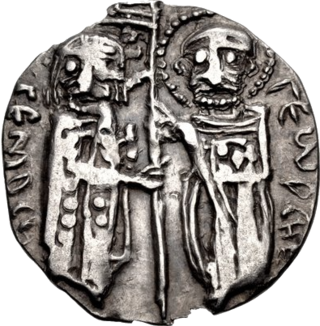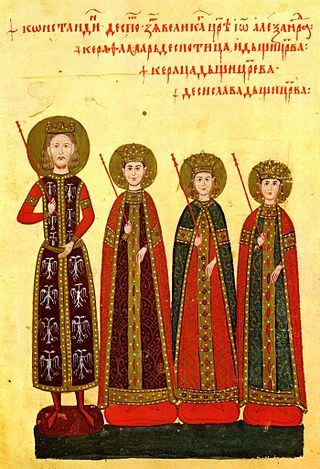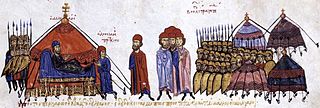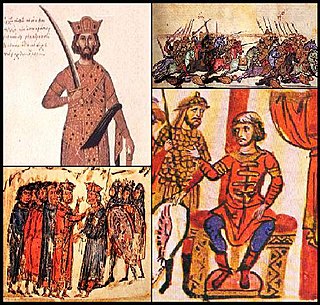
Andronikos III Palaiologos, commonly Latinized as Andronicus III Palaeologus, was the Byzantine emperor from 1328 to 1341. He was the son of Michael IX Palaiologos and Rita of Armenia. He was proclaimed co-emperor in his youth, before 1313, and in April 1321 he rebelled against his grandfather, Andronikos II Palaiologos. He was formally crowned co-emperor in February 1325, before ousting his grandfather outright and becoming sole emperor on 24 May 1328.
George Akropolites was a Byzantine Greek historian and statesman born at Constantinople.
Ivan Asen III, ruled as tsar of Bulgaria 1279–1280. Ivan Asen III was the son of Mitso Asen of Bulgaria and Maria of Bulgaria, a daughter of Ivan Asen II of Bulgaria and Irene of Thessalonica. He was probably born in about 1259/60, and died in exile in 1303.

Theodore Svetoslav ruled as emperor (tsar) of Bulgaria from 1300 to 1322. The date of his birth is unknown. He captured northeast fortresses and expanded the territory of the Bulgarian Empire.

George Terter II reigned as tsar of Bulgaria between 1322 and 1323. The exact date of his birth is unknown, but he was born not long before 1307.

Ivan Alexander, also sometimes Anglicized as John Alexander, ruled as Emperor (Tsar) of Bulgaria from 1331 to 1371, during the Second Bulgarian Empire. The date of his birth is unknown. He died on 17 February 1371. The long reign of Ivan Alexander is considered a transitional period in Bulgarian medieval history. Ivan Alexander began his rule by dealing with internal problems and external threats from Bulgaria's neighbours, the Byzantine Empire and Serbia, as well as leading his empire into a period of economic recovery and cultural and religious renaissance.
Smilets reigned as tsar of Bulgaria from 1292 to 1298.

George Terter I, of the Terter dynasty ruled as tsar of Bulgaria 1280–1292. He was born in Cherven. The date of his birth is unknown, and he died in 1308/1309.

Konstantin (Kostadin) Dejanović or Konstantin Dragaš was a Serbian magnate that ruled a large province in eastern Macedonia under Ottoman suzerainty, during the fall of the Serbian Empire. He succeeded his older brother Jovan Dragaš, who had been an Ottoman vassal since the Battle of Maritsa (1371) which had devastated part of the Serbian nobility. The brothers had their own government and minted coins according to the Nemanjić style. His daughter Jelena married Byzantine Emperor Manuel II Palaiologos in 1392. He fell at the Battle of Rovine, serving the Ottomans against Wallachia, fighting alongside Serbian magnates Stefan Lazarević and Marko Mrnjavčević.

Mitso Asen, not Micho Asen, in Greek, Μύτζης, Mytzēs, was the tsar of Bulgaria from 1256 until 1257.

Alusian was a Bulgarian and Byzantine noble who ruled as emperor (tsar) of Bulgaria for a short time in 1041.

The Byzantine–Bulgarian wars were a series of conflicts fought between the Byzantine Empire and Bulgaria which began after the Bulgars conquered parts of the Balkan peninsula after 680 AD. The Byzantine and First Bulgarian Empire continued to clash over the next century with variable success, until the Bulgarians, led by Krum, inflicted a series of crushing defeats on the Byzantines. After Krum died in 814, his son Omurtag negotiated a thirty-year peace treaty. Simeon I had multiple successful campaigns against the Byzantines during his rule from 893 to 927. His son Peter I negotiated another long-lasting peace treaty. His rule was followed by a period of decline of the Bulgarian state.
Emperor John may refer to:

The siege of Constantinople (1235) was a joint Bulgarian–Nicaean siege on the capital of the Latin Empire. Latin emperor John of Brienne was besieged by the Nicaean emperor John III Doukas Vatatzes and Tsar Ivan Asen II of Bulgaria.
Maria Palaiologina Kantakouzene was an Empress consort of Bulgaria by marriage to two Bulgarian emperors, Constantine Tikh and Ivaylo. She was a niece of Michael VIII Palaiologos.
Irene Palaiologina was the eldest daughter of Byzantine emperor Michael VIII Palaiologos and empress Theodora Palaiologina, and empress consort of Ivan Asen III of Bulgaria.
Michael Doukas Glabas Tarchaneiotes or Michael Tarchaneiotes Glabas was a notable Byzantine aristocrat and general. He served under emperors Michael VIII Palaiologos and Andronikos II Palaiologos in the Balkans, fighting against the Second Bulgarian Empire, Serbia, the Angevins of Naples and the Despotate of Epirus. He is also notable as the patron of several churches, most notably the Pammakaristos Church in Constantinople, where he was buried.
Theodora Palaiologina was a Byzantine princess who became a Bulgarian empress as wife of the emperors Theodore Svetoslav from 1308 to his death in 1321, and Michael Shishman from 1324 to his fall in the Battle of Velbazhd on 28 July 1330.
This page is based on this
Wikipedia article Text is available under the
CC BY-SA 4.0 license; additional terms may apply.
Images, videos and audio are available under their respective licenses.









